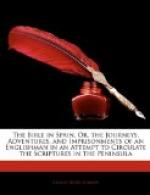Nothing is more calculated to interest the stranger as he wanders through Seville, than a view of these courts obtained from the streets, through the iron-grated door. Oft have I stopped to observe them, and as often sighed that my fate did not permit me to reside in such an Eden for the remainder of my days. On a former occasion, I have spoken of the cathedral of Seville, but only in a brief and cursory manner. It is perhaps the most magnificent cathedral in all Spain, and though not so regular in its architecture as those of Toledo and Burgos, is far more worthy of admiration when considered as a whole. It is utterly impossible to wander through the long aisles, and to raise one’s eyes to the richly inlaid roof, supported by colossal pillars, without experiencing sensations of sacred awe, and deep astonishment. It is true that the interior, like those of the generality of the Spanish cathedrals, is somewhat dark and gloomy; yet it loses nothing by this gloom, which, on the contrary, rather increases the solemnity of the effect. Notre Dame of Paris is a noble building, yet to him who has seen the Spanish cathedrals, and particularly this of Seville, it almost appears trivial and mean, and more like a town-hall than a temple of the Eternal. The Parisian cathedral is entirely destitute of that solemn darkness and gloomy pomp which so abound in the Sevillian, and is thus destitute of the principal requisite to a cathedral.
In most of the chapels are to be found some of the very best pictures of the Spanish school; and in particular many of the masterpieces of Murillo, a native of Seville. Of all the pictures of this extraordinary man, one of the least celebrated is that which has always wrought on me the most profound impression. I allude to the Guardian Angel (Angel de la Guardia), a small picture which stands at the bottom of the church, and looks up the principal aisle. The angel, holding a flaming sword in his right hand, is conducting the child. This child is, in my opinion, the most wonderful of all the creations of Murillo; the form is that of an infant about five years of age, and the expression of the countenance is quite infantine, but the tread—it is the tread of a conqueror, of a God, of the Creator of the universe; and the earthly globe appears to tremble beneath its majesty.
The service of the cathedral is in general well attended, especially when it is known that a sermon is to be preached. All these sermons are extemporaneous; some of them are edifying and faithful to the Scriptures. I have often listened to them with pleasure, though I was much surprised to remark, that when the preachers quoted from the Bible, their quotations were almost invariably taken from the apocryphal writings. There is in general no lack of worshippers at the principal shrines—women for the most part—many of whom appear to be animated with the most fervent devotion.




